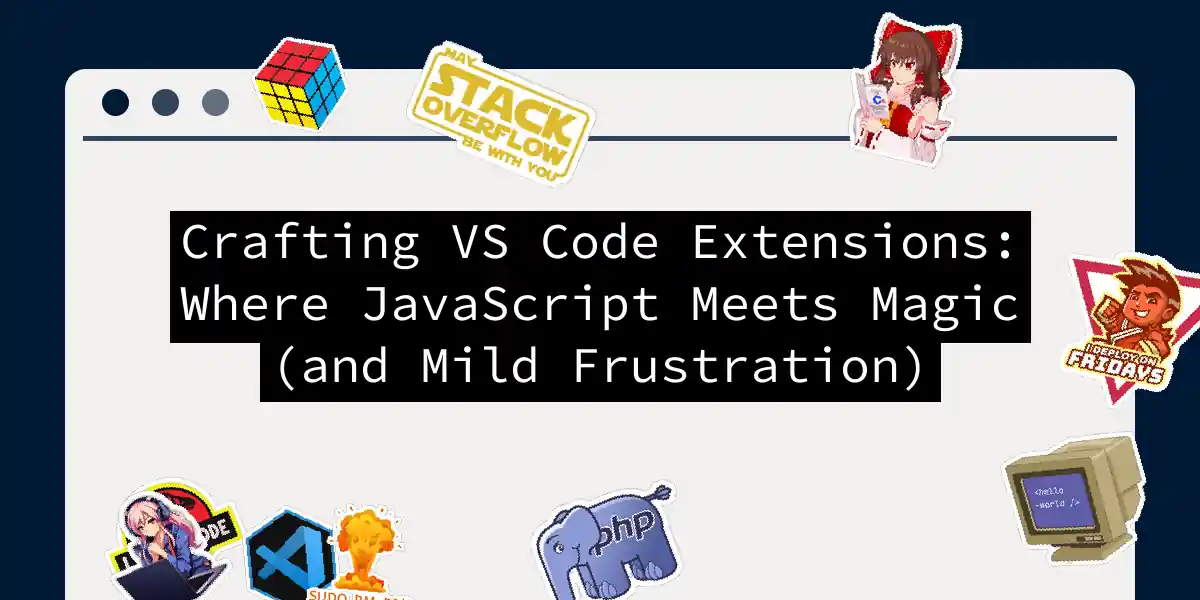So you want to build VS Code extensions? Excellent choice! You’re about to enter a world where you can make editors bend to your will… provided you survive the initial configuration chaos. Let’s turn that “Hello World” into “Hello Productive Workflow” with some JavaScript wizardry.
1. Setting Up Your Extension Workshop
First, arm yourself with these tools:
- Node.js (v18+ unless you enjoy version errors)
- Yeoman (
npm install -g yo) - VS Code Extension Generator (
npm install -g generator-code) Now run your initiation ritual:
yo code
You’ll face The Questionnaire™. Choose “New Extension (JavaScript)” unless TypeScript enthusiasts are peer-pressuring you. Pro tip: When asked about Git repository, enter your GitHub profile unless you plan to hide this project like nuclear codes.
2. Anatomy of an Extension
Your generated project contains critical files:
.
├── .vscode
├── test
├── extension.js # Main drama center
├── package.json # Where dreams get configured
└── vsc-extension-quickstart.md # The manual you'll pretend to read
Here’s the lifecycle of your extension visualized:
3. Your First Actual Code
Replace the default command in extension.js with something spicier:
function activate(context) {
let disposable = vscode.commands.registerCommand('helloworld.helloWorld', () => {
// Make editor beg for mercy
vscode.window.showInformationMessage('Your Code Obeys Me Now!');
// Insert text like a digital vandal
const editor = vscode.window.activeTextEditor;
if (editor) {
editor.edit(editBuilder => {
editBuilder.insert(editor.selection.active, '✍️ Written by extension overlord');
});
}
});
context.subscriptions.push(disposable);
}
Test this masterpiece by hitting F5. A new VS Code window emerges like Frankenstein’s monster - your personal playground.
4. Adding Real Superpowers
Let’s create a status bar item that counts your procrastination time:
let statusBarItem;
function updateStatusBar() {
const text = `Procrastinating for ${Math.floor(Math.random() * 60)} minutes`;
statusBarItem.text = text;
}
function activate(context) {
statusBarItem = vscode.window.createStatusBarItem(vscode.StatusBarAlignment.Right, 100);
statusBarItem.command = 'extension.procrastinationTracker';
context.subscriptions.push(statusBarItem);
setInterval(updateStatusBar, 60000);
updateStatusBar();
statusBarItem.show();
}
Now you’ll always know exactly how unproductive you are - thanks to your own creation!
5. Debugging: The Art of Console.Log Sorcery
When things break (they will), use these weapons:
console.log('Reached this line'); // Classic never dies
vscode.window.showErrorMessage('This should never happen (it just did)');
Debug configuration in .vscode/launch.json is your best frenemy. Set breakpoints and watch variables like a code detective.
6. Publishing: Showtime for Your Extension
Package your masterpiece:
npm install -g vsce
vsce package
You’ll get a shiny .vsix file. Upload it to the VS Code Marketplace and watch the (imaginary) downloads roll in!
7. Pro Tips from the Trenches
- Automate configuration: Use
vscode.workspace.getConfigurationto make users customize without touching JSON - Handle disposables: Unless you want memory leaks eating your RAM like cookie monster
- Test on real victims: Friends make excellent beta testers (until they block you) Remember: Every great extension started as someone stubbornly refusing to Google “how to do this manually”. Now go make that editor your minion! 🧙♂️ (Code samples tested on VS Code v4.2.1. May cause sudden urges to rewrite in TypeScript. Side effects include GitHub stars and imposter syndrome.)
